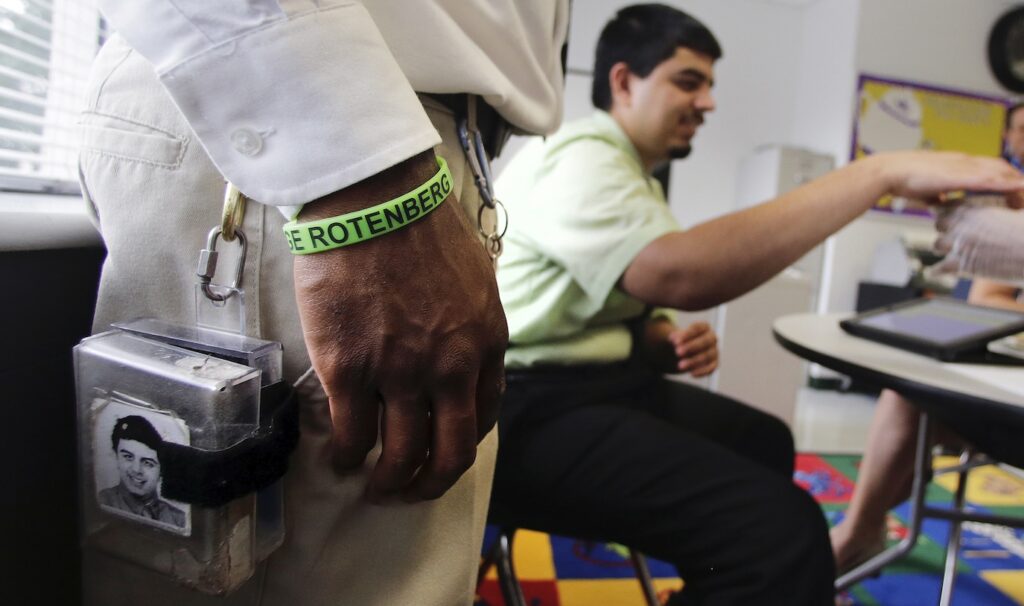Pain and Shock in America: Politics, Advocacy, and the Controversial Treatment of People with Disabilities
Jan Nisbet, with contributions by Nancy R. Weiss
Brandeis University Press, $40 (cloth)
Irony is a constant companion in autism’s search for a home in an inhospitable society. But the story of the Judge Rotenberg Educational Center in Canton, Massachusetts is rich beyond reason. Founded fifty years ago during a humanitarian wave that established community alternatives to the incarceration of disabled people in state asylums, the school became the only place in the United States to employ electric shock to correct autistic behavior.
In Pain and Shock in America: Politics, Advocacy, and the Controversial Treatment of People with Disabilities, Jan Nisbet chronicles the history of this school, which deploys the “Graduated Electronic Decelerator” (GED). From a battery pack strapped around students’ backs, the decelerator’s wires travel under students’ clothing to their arms, legs, and torso. The shock, triggered by remote control, pulses through cathodes fastened to the skin. This is an entirely different treatment than electroconvulsive therapy for severe depression; the sole purpose of electric skin shock is to inflict pain.
The Judge Rotenberg Center opened under its original name, the Behavior Research Institute, in Providence, Rhode Island in 1971. A sister school opened in the San Fernando Valley of Los Angeles, California in 1976. Since the 1990s, after problems in Rhode Island and California forced the schools’ closure in those states, it has operated exclusively in Massachusetts, running a day school and approximately forty group homes for developmentally disabled students sent by school districts across the country. Autism has always been the school’s focus, although Nisbet reports that in recent years it has admitted increasing numbers of misbehaving transfers from juvenile court and foster care. Annual tuition—paid by public school districts and, thus, taxpayers—is $277,915.
The one constant in the school’s history, Nisbet finds, is its use of punishment to modify students’ behavior. Before introducing the decelerator in 1990, teachers and clinicians programmatically handcuffed students, pinched their feet, squeezed their muscles, dumped buckets of cold water on their heads, sprayed ammonia vapor in their faces, and withheld food. Nisbet quotes from an internal 1979 memorandum by Dr. William Bronston, medical director of the California Department of Developmental Services, depicting the school’s “unrelenting pursuit of traumatic aversive interventions” against its most “powerless and undefended” students as central to its value system. “The insistence and pride in using aversive interventions as a mainstay in the BRI program results in the most diabolical and preposterous propositions,” Bronston added.
Parents and ex-staffers filed child abuse complaints. Medical examiners autopsied the bodies of students who died under suspicious circumstances. But no criminal liability was attached to the school until 2011, when a grand jury convened by the Massachusetts attorney general returned indictments against founder Matthew Israel on charges of obstructing justice. A deferred prosecution agreement secured his resignation.
By then the school operated under a consent decree that continues to allow Massachusetts to use electric shocks on disabled people—it is the only state where this is the case. Rhode Island permanently withdrew all its students in 1976; California brought the school to heel through regulatory hearings, licensing battles, and attrition as more parents refused to send their children there; and a settlement in 1989 prohibited its further use of punishments. In Massachusetts, however, the school dug in.
The state’s Office for Children issued an emergency license suspension in 1985 in response to the death of twenty-two-year-old student Vincent Milletich. During a punishment procedure that placed Vincent’s hands and feet in handcuffs and lowered a White Noise Visual Screen Helmet over his head, the young man went limp. He was pronounced dead an hour later at a local hospital. The school lost a class action appeal of the emergency order in U.S. District Court but found a way to sidestep it by seeking a restraining order and preliminary injunction in the lower, county probate court where its group homes were located. After years of fighting over jurisdiction, a consent decree permitted punishments on a case-by-case basis, subject to the approval of the probate court. In 1994 the school consolidated its operations in Massachusetts and changed its name from the Behavior Research Institute to the Judge Rotenberg Educational Center in honor of Ernest Rotenberg, the county judge who saved it.
Critics also dug into the school. U.S. Senator Lowell Weicker of Connecticut asked the Civil Rights Division of the Department of Justice to investigate the school in 1986; no investigation appears to have been undertaken. A second appeal ended in a puzzle: “Although the Department of Justice announced an investigation of JRC in February 2010 in response to a letter signed by thirty-one disability organizations and the investigation was conducted,” Nisbet writes, “no reports or outcomes from the investigation were ever made public, and no action was taken to restrict the use of painful procedures.”
In 2013 a Special Rapporteur concluded that the GED violates the UN Convention Against Torture. According to Nisbet, the device is a tool of institutional violence and intimidation. Former students subjected to the device believe it represents society’s contempt for them. Resident Andre McCollins received thirty-one shocks over seven hours in 2002, initially for failing to obey a command to remove his jacket, and then for screaming in pain from the shocks. A judge in a civil suit released the video footage, which spread widely on YouTube. In 2007 two teenagers received shocks for no reason at all.
In 2020—at the urging of six U.S. senators, a dozen members of the U.S. House of Representatives, and scores of disability rights groups—the Food and Drug Administration (FDA) banned electrical stimulation devices intended to change behavior. The school sued the agency, lost in the trial court, and then appealed. On July 6 of this year, the D.C. Circuit of the U.S. Court of Appeals overturned the ban. The FDA filed a petition for reconsideration in September. The case remains unresolved.
Nisbet reports this back-and-forth surefootedly and fair-mindedly. Parents of some of the students at the school, she writes, have long attested that the device is indispensable for treating self-injurious, life-threatening behaviors. Nisbet feels for their plight. “Most of these families have children excluded from educational and treatment programs because of the severe nature of their behaviors and have challenged or exhausted the existing systems of education and human services,” she writes. Placement at the Rotenberg Center is often “a last resort.”
Yet Nisbet is sure that this option would not be available without the school’s cunning. She narrates the school’s use of the law during the uncertain era of newly de-institutionalized systems of schooling and residential care for autism. The school sidestepped licensure requirements, stiff-armed building inspectors, menaced ex-staffers, and muscled state legislators with lobbying by the firms of Rudolph Giuliani in New York and former Governor Pat Brown in California.
On the core question of the behavioral science, Nisbet contextualizes the history in a similar way. In the 1970s, she agrees, punishment was a signal feature of Applied Behavior Analysis (ABA), an industry-wide model for autism treatment that the school still employs and cites in its defense. In the 1980s a splinter group proposed Positive Behavior Supports (PBS). Rather than punishing failure, PBS rewarded success. A proponent of PBS, Nisbet suggests that parents and judges have been fooled by obsolete science.
The Rotenberg Center, so understood, is a product of a unique set of circumstances, its reign of punishments an egregious exception to the progress made by self-correcting behavioral scientists and educators in remediating autistic behaviors. This same tragic narrative has framed television specials on ABC’s Nightline (1984), The Oprah Winfrey Show (1993), and CBS’s Eye-to-Eye (1994), as well as CNN’s coverage today by Anderson Cooper. The two-sided controversy feeds debate or, as has happened more than once, a shouting match. Audiences tolerate the ugliness at the heart of the story because it is positioned as remote from their own experience: look at the methods used on this one group of unfamiliar children at this singular school—what a shame.
A quieter possibility is squeezed out of the binary narrative of positive versus negative approaches. Professional behavior analysts today hold a monopoly on service models at U.S. schools and centers for autistic people. Their education means, first and foremost, behaving correctly in an institutional environment. In pursuit of the mission of social control, leaders in the profession have been reluctant to wholly remove the iron fist from the velvet glove that they present to the public. The most recent National Institutes of Health Consensus Development Conference on the subject took place in 1989. Experts in behavioral disabilities refused to exclude punishments from their standard of care—“a major setback,” Nisbet concedes. Nobody knows the extent of punishment in contemporary autistic schools and centers. But if, as Nisbet insists, the Rotenberg Center does not represent professional behavior analysis today, then why do professional behavior analysts routinely entertain presentations by the school’s clinicians at professional conferences? Why has the effort to mount a persuasive critique of punishment from within behaviorism proved so difficult?
Maybe it is because the impediment has always been behaviorism itself. Founder Matthew Israel received his PhD under behaviorism’s originator, Harvard psychologist B.F. Skinner. Israel set out to perform an experiment to test Skinner’s theory and Skinner repeatedly defended the results amid the outcry. “You can be opposed to punishment but you can’t just give it up until you’ve got something to replace it,” Skinner told the Boston Globe in 1981 about his protégé’s methods. “There may be a point beyond which you give up on miscarriages of nature.”
Behaviorism transforms persons into objects of scientific inquiry by recording observable cues elicited from conditioned responses. Skinner insisted that subjective states of mind could have no bearing on changes in behavior. Israel was not alone in seeing the relevance for the treatment of nonverbal and autistic children. Their inner lives, apparently inaccessible, could be presumed to be scientifically valueless. All that mattered was changing the contingencies in the environment until they produced a preferred behavior.
The Rotenberg Center’s zeal for punishment has always been consistent with these premises, as Skinner himself warranted. If you conceive of disabled children as malfunctioning machines, then their behaviors are unintegrated data, not clues to their thoughts and feelings. A remote-controlled electrical device strapped to their bodies is an ingenious hack, a professional obligation. Outside critics ascribe an inherent humiliation to the GED and try to shame behaviorists for using it, but moralism misses the point. The empathy that comes from perspective-taking or reality-sharing between human persons is, to the behaviorist, a clinical distraction. That is as true for reward-based interventions as it is for punishments. The profession as a whole is united against relationship-based education for children with autism.
“It seems almost unbelievable that anyone could ever have taken a theory like behaviorism seriously,” philosopher Charles Taylor opined in the 1980s, while rival camps of Skinnerian behaviorists split hairs over the finer points of punishment. “It takes a very powerful metaphysical set of preconceptions for one to ignore or override so much that is so intuitively obvious about human life, for no valid scientific or explanatory reason.”
Behaviorist theory and research, no less crude today, is an embarrassing reminder of the poverty and stagnation of “special” education that does not attempt to support the emotional lives of disabled students or divulge their individuality.
Applied behaviorism, meanwhile, is ubiquitous. Having returned through the cultural side-door of autism, the science of coercion is expanding on the global scale of digital apps and social media. Shoshana Zuboff’s The Age of Surveillance Capitalism attributes the emergence of mass online behavioral engineering to Skinner’s writings and compares it with twentieth-century totalitarianism.
“Likes” and “follows” are a far cry from the GED. But as Alfie Kohn shows in his book, Punished by Rewards, and as we are all discovering in the Facebook files, reward-based algorithms, too, can be toxic, inducing mistrust, anxiety, and depression. That’s what happens when people are mistaken for machines and turned into spectators of their own lives. How a discredited Harvard psychologist has become the unofficial ideologist of both Silicon Valley and disability treatment is a problem beyond the intramural scope of Pain and Shock in America. The book, even so, indexes the post-human society that is cornering us all.







